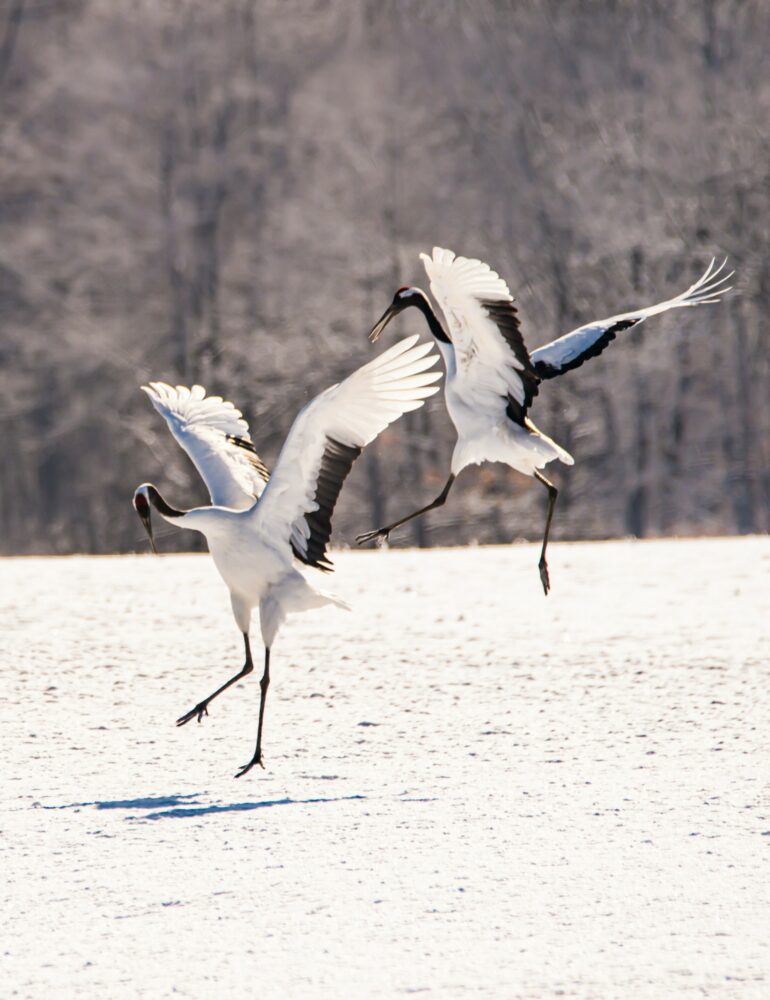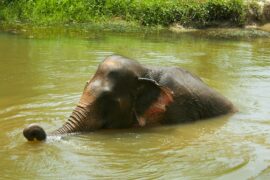We love Japan in the winter. Yes, it’s cold. But the chillier months in Japan have a whole sleighful of attractions if you’re willing to brave the temperatures. Hot springs, skiing, illuminations, snow festivals, warming hotpots and hot sake are just the start of it. The skies are often bright and clear, the gardens are sparkling with a dusting of frost, and the landscape is buried under a deep, enchanting blanket of snow.
And for nature lovers, there’s something extra special to be found in the country’s chillier months: Japan’s winter wildlife.
What wildlife is there in Japan?
Japan has wonderful wildlife from top to toe, but in the winter there’s one place that stands out: Hokkaido.
Hokkaido is the northernmost of Japan’s four main islands. Here, rugged peninsulas jut out into seas crowded with ice floes, while Siberian winds scour snowy mountaintops. Few international visitors make it this far out. Those who do are richly rewarded.
From the following list of Japan’s winter wildlife, all but one are best spotted in Hokkaido — look out for the exception!
Red-crowned crane
Arguably the most spectacular of all Japan’s winter wildlife, the red-crowned crane (or tancho crane) is a symbol of good fortune and longevity in traditional Japanese culture.
Before the Meiji Period (1868-1912) these majestic birds could be found all over Japan, and you can often see them in woodblock prints and kimono fabric designs from that era. Gradually, however, hunting and the disappearance of their natural habitat pushed the crane almost to extinction. In 1924 there was just one flock of 20 birds in the Kushiro Marshlands, near Tsurui.
Since then, conservation efforts have helped rebuild the red-crowned crane population, and there are now large numbers of cranes living in eastern Hokkaido. Tsurui is the place to see them, and you certainly won’t be the only one there. Ranks of keen photographers wait in the popular spots for the perfect shot — and they’re rarely disappointed.
Red-crowned cranes mate for life and are renowned for their complicated and beautiful ‘duets’: dance-like choreographies of movements and calls performed in pairs. Incorporating elements of mating ritual, bonding exercise, territorial advertisement and warning to others, the duets’ complex social meanings aren’t fully understood. Nevertheless, it’s a mesmerising spectacle to witness.
Steller’s sea eagle
The biggest eagle in the world by mass (the Philippine eagle has it pipped for wingspan), the Steller’s sea eagle is a magnificent sight.
These enormous, mean-looking birds are pretty much only found in far-eastern Russia and Hokkaido. A Steller’s sea eagle coming at you with two-metre wingspan and hooked talons strong enough to slice straight through a human arm — that’s not something you’d want to mess with.
Luckily, these eagles are only interested in fish and small mammals, so unless you’re a delicious-looking salmon you’re safe to marvel at their aerial displays from an icebreaker on the Okhotsk Sea (our favourite way to spot them).
Steller’s sea eagles winter in Hokkaido from January to March, congregating over the sea ice to feast on cod, pollock, crabs, squid, ducks and gulls. They’re usually top of any birder’s wish list on a visit to Japan, and the waters around the Shiretoko Peninsula are particularly good for sightings of large groups wheeling, diving, and occasionally squabbling over their catches.
With only four to five thousand individuals left in the wild, Steller’s sea eagles are classified as vulnerable, and are officially considered a national treasure in Japan.
White-tailed eagle
Existing alongside the Steller’s sea eagle (mainly peacefully; sometimes not so peacefully) is the white-tailed eagle. It’s slightly smaller than the Steller’s, but with the same, bright yellow, “I-mean-business” beak and talons.
White-tailed eagles have a very wide distribution across Europe and Asia and are not an endangered species, so they’re not as sought-after as the Steller’s — but they are beautiful nonetheless. During the winter, they congregate in large flocks, swooping and diving for prey, and sometimes engaging in exciting aerial battles with Steller’s eagles over food.
Spotted seals
When you’re out looking for sea eagles, keep an eye out for spotted (or largha) seals hanging out on the ice.
Historically, these seals kept to the waters of the Okhotsk Sea, but since the Soya Strait between Hokkaido and Sakhalin stopped freezing over in the winter they’ve started venturing as far south as the Sea of Japan. They’ve become a controversial presence for pilfering fishermens’ catches, but they sure are cute.
Blakiston’s fish owl
The Blakiston’s fish owl is an evolutionary mystery. Possessing some characteristics of a fish owl (ragged, side-projecting ear tufts) and some of eagle owls (silent wingbeats), scientists aren’t entirely sure where it fits in.
Some theorise that it represents a ‘missing link’ in the evolutionary chain between the fish owl and the eagle owl, while others suggest that it’s an eagle owl that developed the characteristics of a fish owl completely separately (an example of convergent evolution). Either way, it’s a rare and beautiful bird, which makes it thoroughly unsurprising that the indigenous Ainu people of Hokkaido revered it as a god named Kotan Koru Kamuy, or “God that protects the village.”
If you had to pick an animal to protect your village, a Blakiston’s fish owl would be a fine choice. They’re the largest species of owl in the world, with a wingspan approaching two metres and a weight of up to 4.6 kg. Though they feed mainly on small fry (fish, frogs, crustaceans, small mammals) they have been known to kill cats, dogs, foxes, and fish three times their own weight. Their patience is phenomenal, and they can sit stock-still for up to four hours waiting for their moment to strike. So yes — they could protect your village. If they wanted to.
Blakiston’s fish owls are endangered due to the widespread loss of their natural habitat, but about 100 to 150 remain in Hokkaido. Rausu, on the Shiretoko Peninsula, is one of the best places to spot them.
Ural owl
The Ural owl is far more common than the Blakiston’s fish owl (it’s found in forests all over Eurasia), but the Japanese variety is unique and interesting to birders for its white, speckled feathers.
Like the Blakiston’s fish owl, it’s a large forest owl that makes its nests in tree cavities and is most active in the crepuscular hours. They’re easy to spot in the bare branches of winter trees, and during their courtship period from January to March they can be seen ‘cuddling’ and preening each other in pairs. Cute.
Ezo Red fox
Ezo red foxes, also called Kitakitsune (“northern fox”), are Hokkaido’s version of the common red fox found all over Japan. Larger than their southern cousins, they range widely across the island, subsisting on rates, hares, birds and insects, plus fruit & nuts when available. They make their lairs in holes and tunnels, and can be spotted pretty much all over (even in urban areas, where they’ve settled since the 1980s).
There are many animals in Hokkaido with the name “Ezo”, or “Yezo”. It means “foreigner” in Japanese, and comes from the old name for Hokkaido, Ezochi, which means “land of the foreigner”. Many don’t realise that Hokkaido only became part of Japan in 1869, and that the “foreigner” in question is the indigneous Ainu whom they displaced. Today, the Ainu people have been almost completed absorbed into the Japanese population, and their culture survives primarily in museums.
Whooper swan
The whooper swan — or common swan — can’t claim rarity (it’s found all over Eurasia, including the UK), but the spectacle of over 300 of these elegant, white birds wintering on Lake Kussharo is one of the more beautiful winter wildlife experiences in Japan.
The swans spend most of their year in Siberia, but come to Lake Kussharo in the winter to take advantage of the thermal springs which ensure that the lake remains unfrozen around the shore. In the cold, clear mornings, with steam billowing from the water, it’s a magical sight.
You can also spot a litany of other wildlife in the area, including white-tailed eagles, buzzards, brown hawk owls, yellow-breasted greenfinches, sika deer, sable, mountain hare and Siberian chipmunks.
Ezo flying squirrel
With its tiny grey body and enormous, Pokémon-like eyes, the Ezo flying squirrel has to be one of the cutest winter animals you can spot in Japan. If you want to see one, you’ll have to be up early, as they usually only feed at daybreak. With a good guide and a little patience, they’re not hard to spot.
Flying squirrels can be found anywhere in Hokkaido that has old growth forest, where they make their nests in tree hollows. The trick is to find an area where there are lots of broken twigs scattered on the snow (dropped by squirrels feeding in the branches), then look for droppings around the base of a tree. Once you’ve identified a nest, look for the squirrels in the branches and watch until they glide into their nests after breakfast. They can sail for up to 50 metres like this — which is perhaps why the Ainu considered them birds rather than mammals.
In Ainu legend, the flying squirrel is the tutelary deity of children, and a symbol of fertility. They were believed to be capable of having 30 young in one litter — which makes the real number (six) somewhat disappointing.
Sable
The Japanese sable is a species of marten, and could give the Ezo flying squirrel a run for its money in the cuteness stakes.
Sadly for the sable, its fur has the unique quality of being smooth when stroked in any direction, and consequently it has been prized by the fur trade since mediaeval times. Nevertheless, sables are not endangered, and can be spotted in the early mornings or late evenings all over Hokkaido. They dig their burrows in thick woods and along riverbanks, often among the roots of trees. They are skilled hunters, preying on rodents, hares, and even small musk deer — but they’re also scavengers, and will follow the tracks of larger predators like bears to feast on their leftovers.
Yezo sika deer
You won’t have to look far for this wildlife experience. Since wolves went extinct in Japan, the sika deer is everywhere.
Unlike most deer in Europe and North America, Japanese deer are not afraid of humans and will even try to rob you of your packed lunch if you’re not careful. They can be found in great numbers in Nara and Miyajima, where locals and tourists feed them sembei crackers. In Hokkaido, they tend to keep out of urban areas.
Yezo sika deer are larger than those found in more southerly regions of Japan, with thick winter coats and antlers over a metre long. Look out for them anywhere and everywhere in Hokkaido.
Ussuri brown bears
The only animal on this list that you might not want to spot — at least not unawares — is the Ussuri brown bear, or Ezo brown bear.
Slightly smaller than a grizzly but much larger than the black bear found further south, this Hokkaido native roams the forests of Hokkaido’s more remote corners. Ussuri brown bears are very shy, and even long-time hikers report having seen them only once or twice in the wild. They’re rarely aggressive unless surprised, so it’s a good idea to hike with a bear bell to warn them of your presence. It means the closest you’re likely to get is a paw print or dropping in the snow, but that’s probably for the best — for you and for the bear.
Snow monkeys
Of course, no overview of Japanese winter wildlife would be complete without mention of the famous “snow monkeys” of Yudanaka.
The only wildlife experience on this list that can’t be found in Hokkaido, this one’s tucked away in the Japanese Alps, in the forest outside of Yudanaka Onsen. Here, the local Japanese macaques have discovered the joys of onsen bathing, huddling together in a steaming hot-spring bath surrounded by snow.
Of course, the monkeys’ fame means that this is a very popular tourist spot, so expect to jostle for pole position if you want to get a good shot. If it’s wilderness and isolation you’re after, perhaps you’re better off sticking to Hokkaido.
Our Winter Highlights Small Group Tour includes a variety of wildlife-spotting activities and cultural highlights — but we can also design independent adventures to suit your interests. Get in touch with us to start planning.



